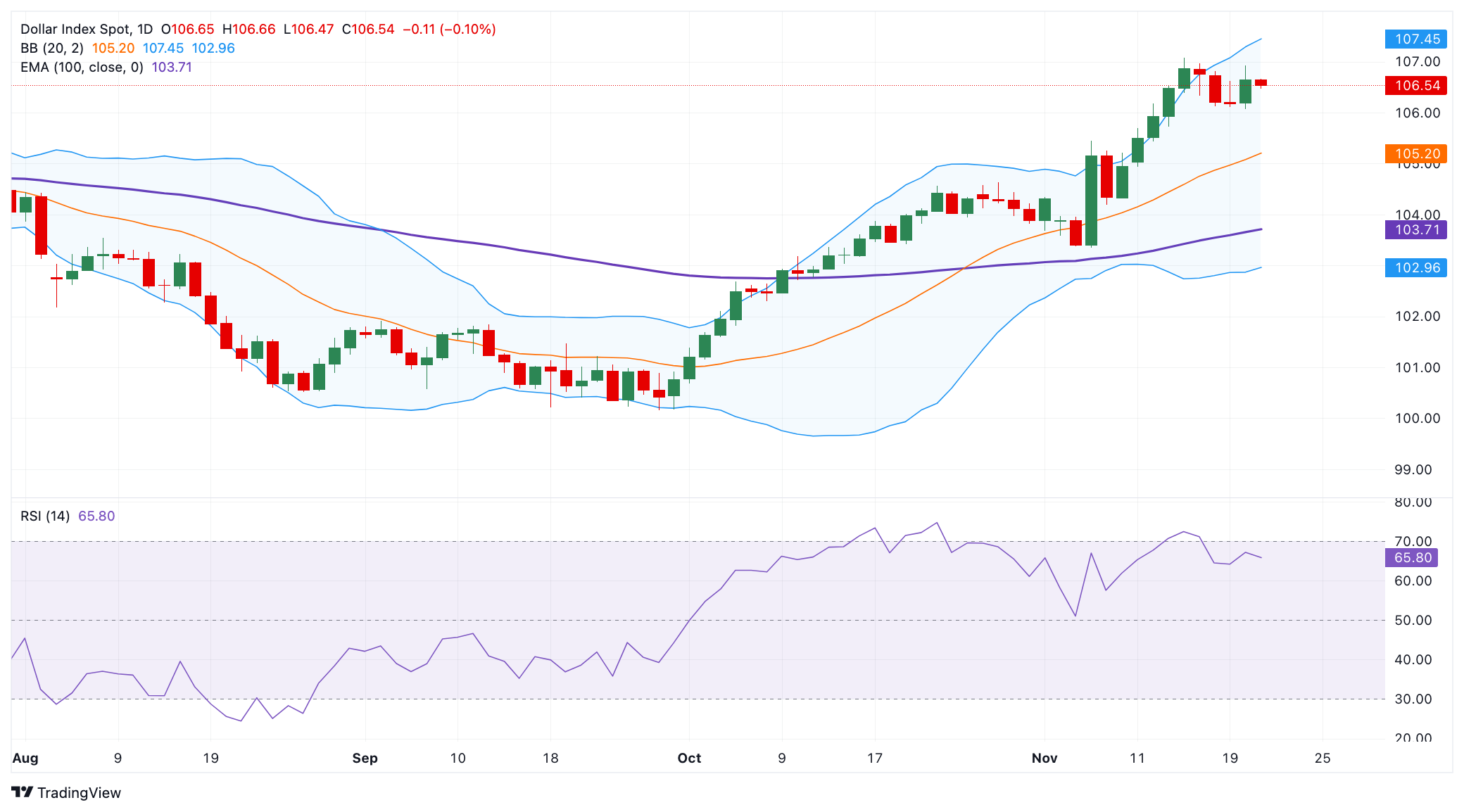- Analytics
- News and Tools
- Market News
- US Dollar Price Forecast: The bullish outlook remains in play near 106.50
US Dollar Price Forecast: The bullish outlook remains in play near 106.50
- The US Dollar Index drifts lower to near 106.50 in Thursday’s early European session.
- The index keeps a positive view with the bullish RSI indicator.
- The immediate resistance level emerges at 107.45; the first downside target to watch is 106.00.
The US Dollar Index (DXY) trades with mild losses around 106.50 during the early European session on Thursday. The downside for the index might be limited as markets expect that Donald Trump’s administration will reignite inflation and slow the path of rate cuts from the Federal Reserve (Fed), supporting the Greenback.
Technically, the bullish trend of the DXY remains intact as the index is well-supported above the key 100-day Exponential Moving Average (EMA) on the daily chart. The 14-day Relative Strength Index (RSI) stands above the midline near 66.40, indicating that the path of least resistance is to the upside.
The first upside target for the DXY emerges near the upper boundary of the Bollinger Band at 107.45. Any follow-through buying above this level could pave the way to 108.00, the high of November 21, 2022. Further north, the next hurdle to watch is the 110.25, the high of September 8, 2022.
In the bearish event, sustained trading below 106.00, the round mark, could see a drop to 104.19, the low of November 7. The key support level is seen at 103.71, the 100-day EMA. A breach of the mentioned level could expose 102.95, the lower limit of the Bollinger Band.
US Dollar Index (DXY) Daily Chart
US Dollar FAQs
The US Dollar (USD) is the official currency of the United States of America, and the ‘de facto’ currency of a significant number of other countries where it is found in circulation alongside local notes. It is the most heavily traded currency in the world, accounting for over 88% of all global foreign exchange turnover, or an average of $6.6 trillion in transactions per day, according to data from 2022. Following the second world war, the USD took over from the British Pound as the world’s reserve currency. For most of its history, the US Dollar was backed by Gold, until the Bretton Woods Agreement in 1971 when the Gold Standard went away.
The most important single factor impacting on the value of the US Dollar is monetary policy, which is shaped by the Federal Reserve (Fed). The Fed has two mandates: to achieve price stability (control inflation) and foster full employment. Its primary tool to achieve these two goals is by adjusting interest rates. When prices are rising too quickly and inflation is above the Fed’s 2% target, the Fed will raise rates, which helps the USD value. When inflation falls below 2% or the Unemployment Rate is too high, the Fed may lower interest rates, which weighs on the Greenback.
In extreme situations, the Federal Reserve can also print more Dollars and enact quantitative easing (QE). QE is the process by which the Fed substantially increases the flow of credit in a stuck financial system. It is a non-standard policy measure used when credit has dried up because banks will not lend to each other (out of the fear of counterparty default). It is a last resort when simply lowering interest rates is unlikely to achieve the necessary result. It was the Fed’s weapon of choice to combat the credit crunch that occurred during the Great Financial Crisis in 2008. It involves the Fed printing more Dollars and using them to buy US government bonds predominantly from financial institutions. QE usually leads to a weaker US Dollar.
Quantitative tightening (QT) is the reverse process whereby the Federal Reserve stops buying bonds from financial institutions and does not reinvest the principal from the bonds it holds maturing in new purchases. It is usually positive for the US Dollar.
© 2000-2024. All rights reserved.
This site is managed by Teletrade D.J. LLC 2351 LLC 2022 (Euro House, Richmond Hill Road, Kingstown, VC0100, St. Vincent and the Grenadines).
The information on this website is for informational purposes only and does not constitute any investment advice.
The company does not serve or provide services to customers who are residents of the US, Canada, Iran, The Democratic People's Republic of Korea, Yemen and FATF blacklisted countries.
Making transactions on financial markets with marginal financial instruments opens up wide possibilities and allows investors who are willing to take risks to earn high profits, carrying a potentially high risk of losses at the same time. Therefore you should responsibly approach the issue of choosing the appropriate investment strategy, taking the available resources into account, before starting trading.
Use of the information: full or partial use of materials from this website must always be referenced to TeleTrade as the source of information. Use of the materials on the Internet must be accompanied by a hyperlink to teletrade.org. Automatic import of materials and information from this website is prohibited.
Please contact our PR department if you have any questions or need assistance at pr@teletrade.global.
















